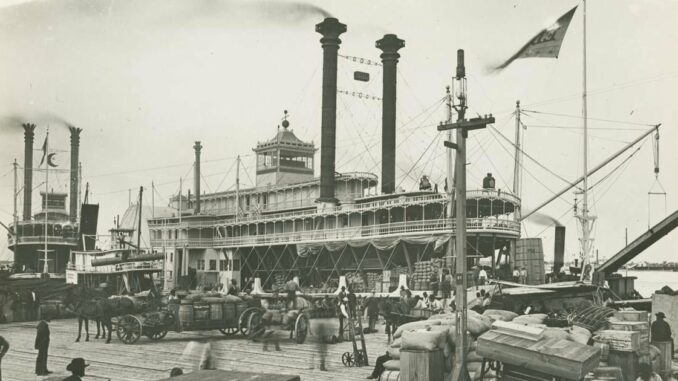
He also equipped it with two separate engines, each connected to its own paddlewheel for better maneuverability.
“Steamboats invaded every Louisiana stream which was navigable, even if only at flood stage,” writes Fred B. Kniffen in his 1968 LSU Press-published textbook, “Louisiana: It’s Land and People.” “Old maps show the extent to which they penetrated every nook and cranny of the state.”
The Steamboat E.J. Gay, named for Louisiana financier and U.S. Sen. Edward James Gay, served as a mode of transport for travelers along Louisiana’s waterways.
There were steamboat lines between Plaquemine on the Mississippi River and Bayou Teche, French Settlement on the lower Amite River and New Orleans and across Lake Pontchartrain between New Orleans and Madisonville.
“We even have documents from the Germantown Colony Museum that document goods taken by boat from New Orleans to the Minden area,” Durusau said. “The documents are at the Louisiana State Archives.”
Meanwhile, Kniffen points out that steamboat traffic peaked in 1860 with the rise of railroads, yet Hasse’s research shows that it was still a popular mode of travel in Louisiana, especially among the state’s legislators.
A story in the Feb. 22, 1882 Daily Capitolian-Advocate, the first official state journal, mentions desks and other furniture being taken to a wharf to be transported to the capitol on the Steamboat E.J. Gay.

Louisiana’s Old State Capitol towers over Baton Rouge in 1880.
The steamboat named for Louisiana financier and U.S. Sen. Edward James Gay was again mentioned on Feb. 24, 1882, once again regarding the furniture.
Then the trains kicked in with a March 1, 1882, story in The Daily Picayune of New Orleans talking about how officials would travel by train from the Crescent City to Baton Rouge.
On that same day, The Capitolian-Advocate also discusses lawmakers’ arrival in Baton Rouge by train, and on March 2, 1882, the newspaper mentions a reception for Louisiana Gov. Samuel Douglas McEnery, his family and other officials arriving by train across the river. City officials left the wharf in Baton Rouge aboard the Steamboat Morning Star to gather the state officials, then returned to capital city on the boat.





Leave a Reply